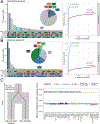50,000 years of evolutionary history of India: Impact on health and disease variation
- PMID: 40578318
- PMCID: PMC12376946
- DOI: 10.1016/j.cell.2025.04.027
50,000 years of evolutionary history of India: Impact on health and disease variation
Abstract
India has been underrepresented in genomic surveys. We generated whole-genome sequences from 2,762 individuals in India, capturing the genetic diversity across most geographic regions, linguistic groups, and historically underrepresented communities. We find most Indians harbor ancestry primarily from three ancestral groups: South Asian hunter-gatherers, Eurasian Steppe pastoralists, and Neolithic farmers related to Iranian and Central Asian cultures. The extensive homozygosity and identity-by-descent sharing among individuals reflects strong founder events due to a recent shift toward endogamy. We uncover that most of the genetic variation in Indians stems from a single major migration out of Africa that occurred around 50,000 years ago, followed by 1%-2% gene flow from Neanderthals and Denisovans. Notably, Indians exhibit the largest variation and possess the highest amount of population-specific Neanderthal ancestry segments among worldwide groups. Finally, we discuss how this complex evolutionary history has shaped the functional and disease variation on the subcontinent.
Keywords: Denisovan ancestry; Neanderthal ancestry; South Asian evolutionary history; adaptation; ancient gene flow; disease susceptibility; founder events; functional variation; genomic diversity in India; peopling of India.
Copyright © 2025 The Authors. Published by Elsevier Inc. All rights reserved.
Conflict of interest statement
Declaration of interests The authors declare no competing interests.
Figures




References
Publication types
MeSH terms
Grants and funding
LinkOut - more resources
Full Text Sources

